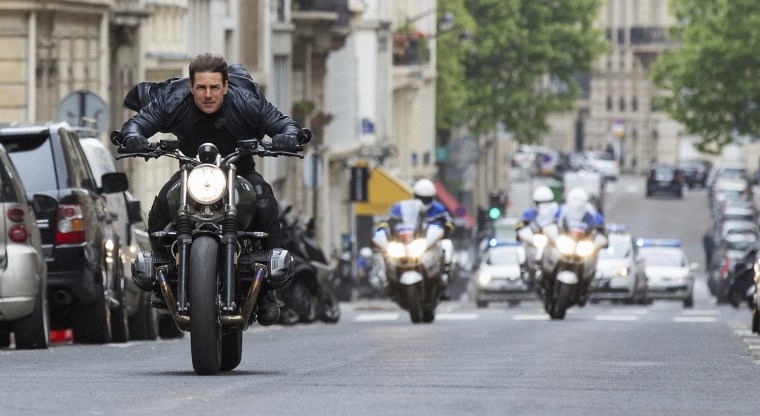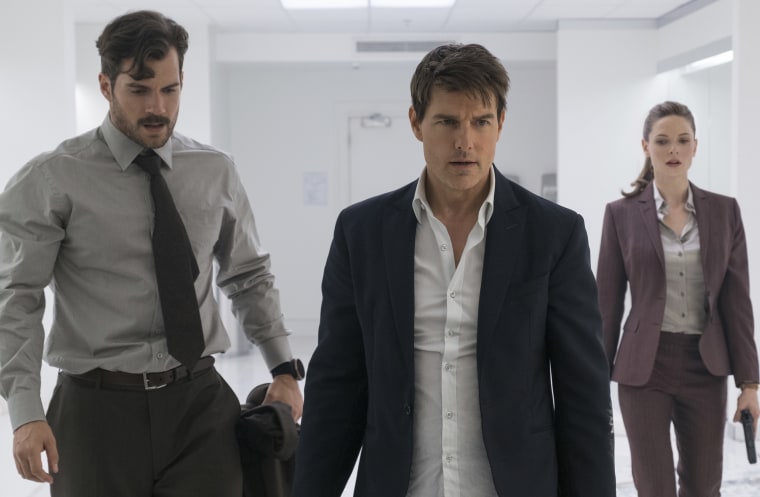Tom Cruise is still out here defying the laws of time and space — and “Mission: Impossible – Fallout” proves it. The sixth film in the 22-years-and-counting franchise opens at the box office this weekend to a lot of buzz. This a blockbuster that somehow feels like it’s been two decades in the making; the end result of a slow distillation of the action genre. It is unfettered by such problems as "logic," "realism," or "physics." It is two hours of marveling at a man four years shy of 60 doing all his own stunts. It is surprisingly old-fashioned in its message that there are still good people in government who care about the individual welfare as well as the greater good.
But to really appreciate this latest impossible mission, one must understand all of the missions that have come before it. The original film was part of an earlier, smaller reboot era during the mid 1990s, when Hollywood mined TV shows from the 1960s and 1970s for big screen fodder. (“The Brady Bunch Movie” was released in 1995, “George of the Jungle” in 1997, “Mission: Impossible” in 1996.) Like the TV show before it, “Mission Impossible” was a spy thriller loosely inspired by James Bond. The film was popular enough to warrant a second installment in 2000, but that felt like the end of the line.
And it was, until 2006, when star and producer Tom Cruise decided to reboot the franchise with J.J. Abrams at the helm. (Cruise and his producing partner at the time, Paula Wagner, backed the entire project, and Cruise took a major pay cut to make sure it stayed within budget.) Since then, Cruise has put out a new "Mission Impossible" roughly every three years, each of which has slowly improved on the last.
This a blockbuster that somehow feels like it’s been two decades in the making; the end result of a slow distillation of the action genre.
The problem with action movies in general is that they are fight-first, plot-second endeavors. Many times the story, no matter how simple, is pushed aside to make room for stunt work and combat sequences. “Mission: Impossible,” as a franchise, has had five directors over six films, each of whom has attempt (or hasn't) to solve these issues in their own way. “Mission: Impossible – Fallout” is notable for being the only film in the franchise with a returning director, Christopher McQuarrie, who helmed the last installment, “Mission: Impossible – Rogue Nation.” McQuarrie’s familiarity with the material, as well as the decision to draw upon the events of the last adventure, makes this film feel less like a standalone project and more like a traditional sequel. Ultimately this is a good thing, because it helps the film balance plot coherence with action, all while maintaining the proper tone.
The plot of the movie isn’t that important, and a description of it would sound ridiculous anyway. All viewers need to remember is that Tom Cruise is a good guy, and Henry Cavill is not. Everything else, including characters who flip from bad to good, sometimes in the same scene, is secondary. But as long as the audience remembers that whatever Cavill’s character, the hilariously named August Walker, is doing is bad, and whatever Cruise’s character Ethan Hunt does — even when it makes zero sense — is good, they’ll be able to follow the twists and turns.
This binary simplicity also hearkens back to the original TV show’s roots. Launched in the 1960s, it was a show about the good people of the government taking down the bad forces of chaos, maintaining law and order in a world where the social order was rapidly changing. But as cynicism about the American government’s intensions grew, shows that lauded them uncritically decreased in popularity. In order to keep up with the times, the 1996 film finds Ethan Hunt being double-crossed by his government, allowing the agent to be good, but the government to be bad.
Over the years, that cynicism has slowly faded. The newest installment ends with a CIA official (Angela Bassett) all but apologizing on behalf of America, having seen the error of her ways, and pledging to help keep governmental institutions honest from now on. If only it were so easy.
Believing in the good of complex institutions, like the government, is an important aspect of Cruise’s character. This maybe makes sense, given that in real life, Cruise is one of the world’s most famous believers in institutions some would call questionable. And make no mistake; this is his film. Of course, so has every other “Mission: Impossible” — he’s produced them all. But there’s something uniquely personal about this franchise.

Cruise has played a lot of roles over his career, plenty of them award-winning. His time in the spotlight has also been exceedingly rocky. But somewhere around the mid-aughts, it feels like Cruise decided he wanted to spend the rest of his life playing Ethan Hunt. The publicity tour for “Mission: Impossible III” went about as badly for him personally as possible — most people don’t remember now, but his infamous couch-jumping incident was actually supposed to be in service of his sexy action hero comeback. And yet, Cruise didn't really care how much his reputation suffered or even how much critics like his movies — he was going to make more anyway. The dogged perseverance — rain, shine, or march of time be damned — is also partly why the films keep getting better, as Cruise and company figure out what works and what doesn't.
And what works is Cruise-as-stuntman. While superhero films are full of stuntmen and CGI, Cruise’s old-fashioned commitment to doing his own stunts, with as little CGI as possible, lends a real superhero — or at least superhuman — feel to the films. Born in 1962, Cruise is 56 years old. He doesn’t look it, however, as his face seems eternally frozen at 39 ½. This phenomenon — impressive, if a little creepy— is made more obvious by the franchise’s only co-star to last all six movies, Ving Rhames. Rhames, who at 59 is three years Cruise’s senior, looks like a man who has grown too old for this stuff. Not Cruise. Whether running at top speed along rooftops, jumping out of windows, or flying flaming helicopters aimed at Henry Cavill’s face, Cruise’s endurance is extraordinary.
But if Cruise is the greatest thing about “Mission: Impossible – Fallout,” he’s also its greatest weakness. His character, Hunt, does not have the trading faces-and-actors timelessness of James Bond, because he’s only ever been played by one actor. So while the franchise may have finally hit its stride, its star seems determined to play the lead until he dies. And no matter how good his training regimen (and medical team), the idea that Cruise will be able to keep doing this at 59 or 62 seems like its own mission impossible.
On the other hand, with box office estimates predicting Cruise will have the biggest opening weekend of his career — ever — I wouldn't be surprised if audiences and critics are marveling at his stamina once again in another three years.
Ani Bundel has been blogging professionally since 2010. Regular bylines can be found at Elite Daily, WETA's TellyVisions, and Ani-Izzy.com.

